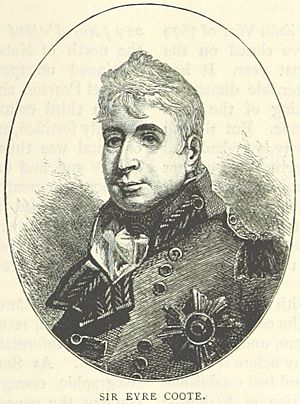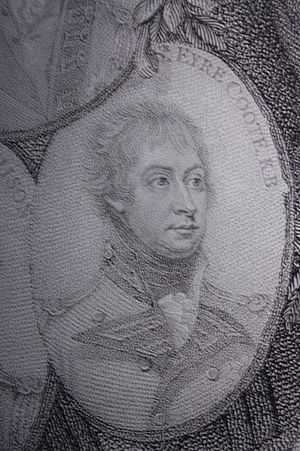Eyre Coote (British Army officer, born 1762) facts for kids
Quick facts for kids
Eyre Coote
|
|
|---|---|

An 1895 illustration of Coote
|
|
| Governor of Jamaica | |
| In office 1806–1808 |
|
| Preceded by | Sir George Nugent, 1st Baronet |
| Succeeded by | William Montagu, 5th Duke of Manchester |
| Personal details | |
| Died | December 10, 1823 (aged 61) |
| Spouses |
|
| Children | Catherine, Sarah and Susannah and Eyre Coote. |
| Parents |
|
| Alma mater | Trinity College Dublin |
| Military career | |
| Allegiance | |
| Service/ |
|
| Rank | General |
| Battles/wars | American War of Independence French Revolutionary Wars |
Eyre Coote (born May 20, 1762 – died December 10, 1823) was an Irish-born British soldier and politician. He reached the high rank of general in the British Army. He also served as the Governor of Jamaica. However, he later lost his military rank and honors in 1816 due to his behavior.
Contents
Early Life and Family
Eyre Coote was the second son of Charles Coote and Grace Tilson. His uncle was the famous General Sir Eyre Coote, who was well-known for his military actions in India. Eyre Coote inherited a lot of land and wealth from his uncle.
Military Career Highlights
Eyre Coote studied at Eton and Trinity College Dublin. In 1774, he joined the army as an ensign. This was a junior officer rank. He joined the 37th Regiment of Foot, where his uncle was the colonel.
Fighting in America
His regiment went to North America to fight in the American War of Independence. He was a flag-bearer at the Battle of Long Island in 1776. He then became a lieutenant. He fought in many important battles, including Brandywine and Germantown. In 1778, he became a captain. He was involved in the siege of Charleston and Lord Cornwallis's campaigns in Virginia. He became a prisoner of war after the surrender at Yorktown.
Service in the West Indies and Europe
After being released, Coote returned to England. He became a major in 1783 and a lieutenant-colonel in 1788. In 1793, when war broke out with France, he went to the West Indies. He led a group of light infantry soldiers and showed great bravery. He was especially praised for his actions at the capture of Morne Fortuné in Guadeloupe.
He was promoted to colonel in 1794. He returned to the West Indies in 1795 and again showed his skill. For his service, he became an aide-de-camp to King George III. This meant he was a personal assistant to the King. In 1796, he became a brigadier-general. By 1798, he was a major-general and was given an important command at Dover.
Expeditions and Battles
While at Dover, Coote led troops in an expedition to Ostend in the Netherlands. The goal was to cut the sluices (water gates) to flood French-held areas. His troops successfully cut the sluices. However, strong winds prevented their ships from picking them up. French troops surrounded them, and after a tough fight, Coote was wounded and forced to surrender. He was later exchanged and returned to Dover.
In 1799, he commanded a division in the Anglo-Russian invasion of Holland. His division fought bravely in the Battle of Bergen.
In 1800, Coote went to the Mediterranean. He played a key role in the British landings in Egypt and in battles there. He commanded the blockade of Alexandria from April to August 1801. When General Hutchinson arrived, Coote was ordered to attack the castle of Marabout, which controlled Alexandria. Coote captured Marabout after a strong fight, leading to the surrender of Alexandria. For his important services in Egypt, Coote was made a Knight of the Bath. He also received an honor from the Sultan.
Later Career and Challenges
Coote was planned to lead an expedition to South America, but this was stopped by the Peace of Amiens. He returned to England and became a Member of Parliament (M.P.) for Queen's County in 1802. He had inherited a lot of property there. He had also served in the Irish House of Commons before.
In 1805, he was promoted to lieutenant-general. He became the lieutenant-governor and commander-in-chief of Jamaica. However, he resigned in 1808 due to poor health. The climate in the West Indies was hard on him.
In 1809, he was second in command for the Walcheren Campaign. He oversaw the siege of Flushing until its surrender. However, his behavior during this expedition showed that he might not be fit for command anymore.
He continued to hold various military positions and was promoted to general in 1814. In 1816, Eyre Coote was removed from his regiment and dismissed from the army. He also lost his honors. He lost his seat in parliament in 1818 and passed away on December 10, 1823.
Family Life
Eyre Coote was married twice. His first wife was Sarah Rodbard (1765–1795). They had three daughters: Catherine, Sarah, and Susannah. His second wife was Jane Bagwell. They had one son, also named Eyre Coote.
Images for kids



